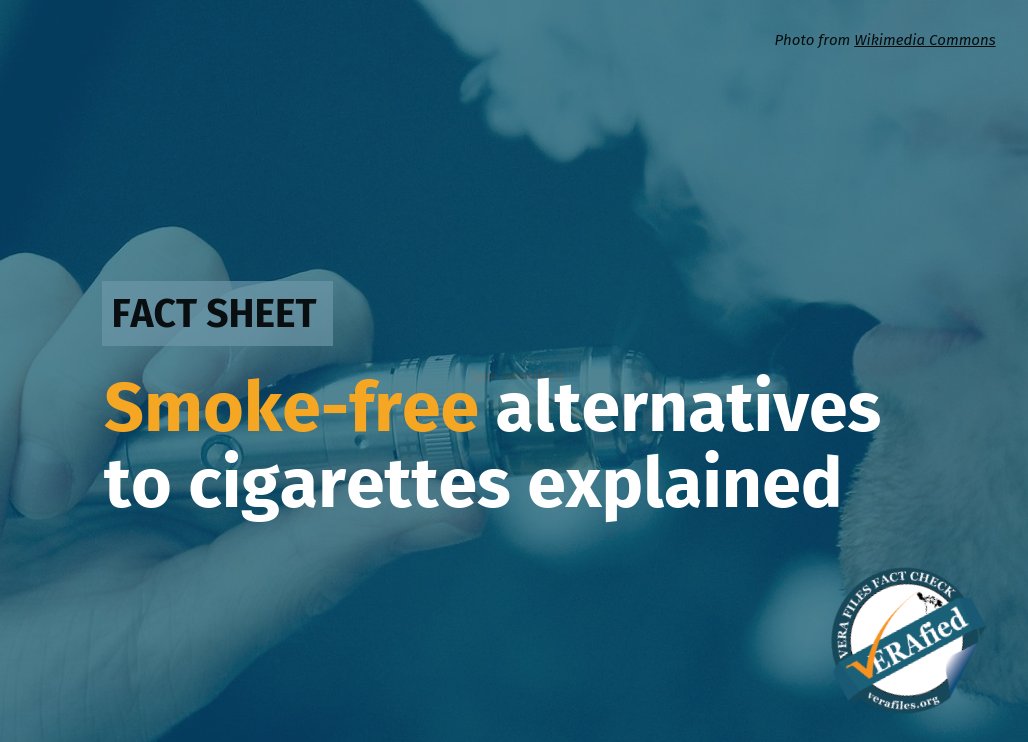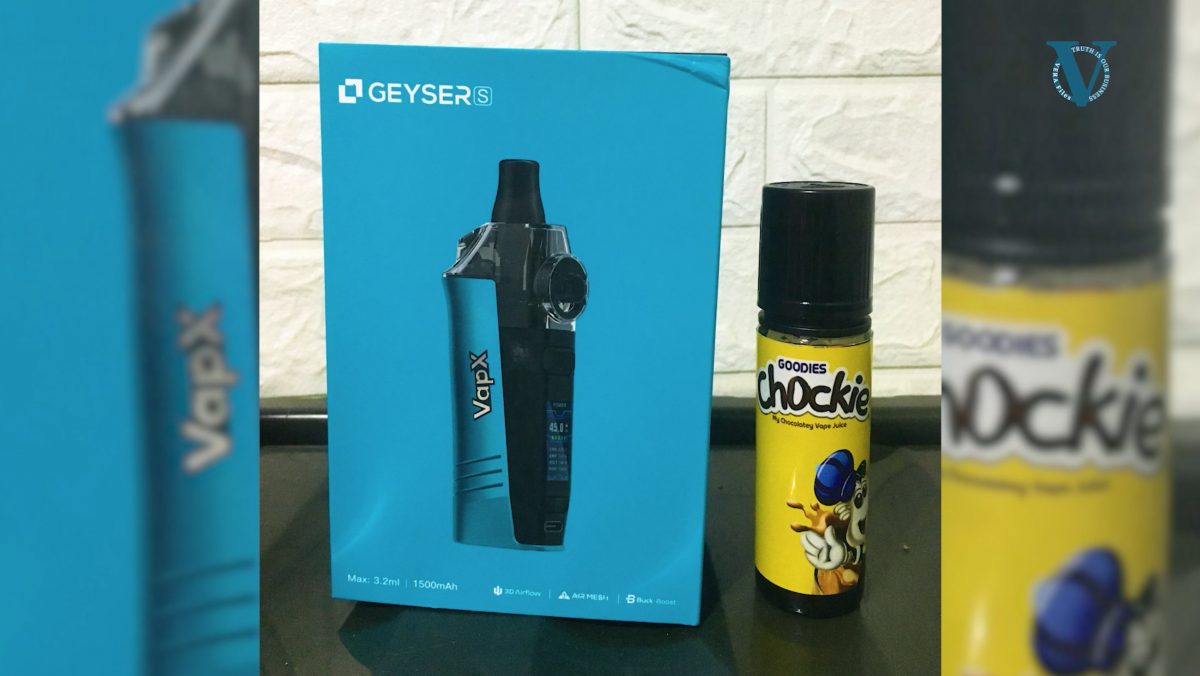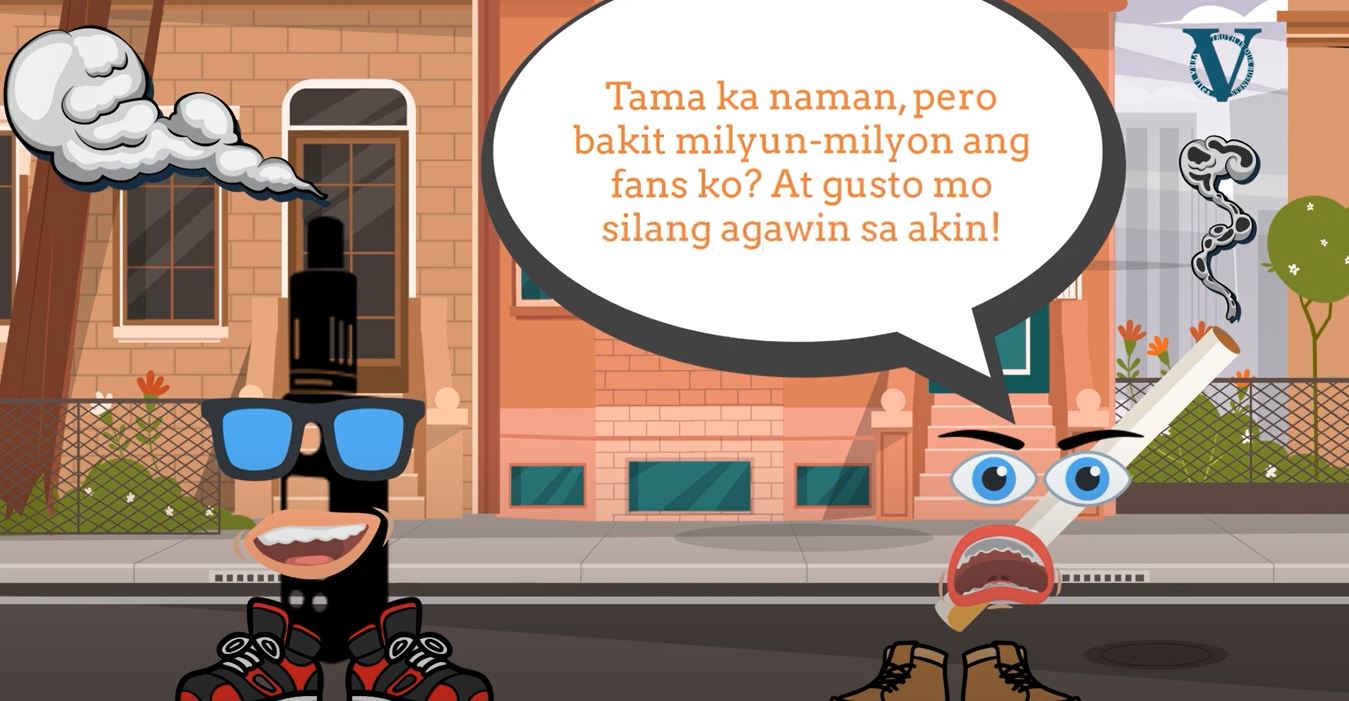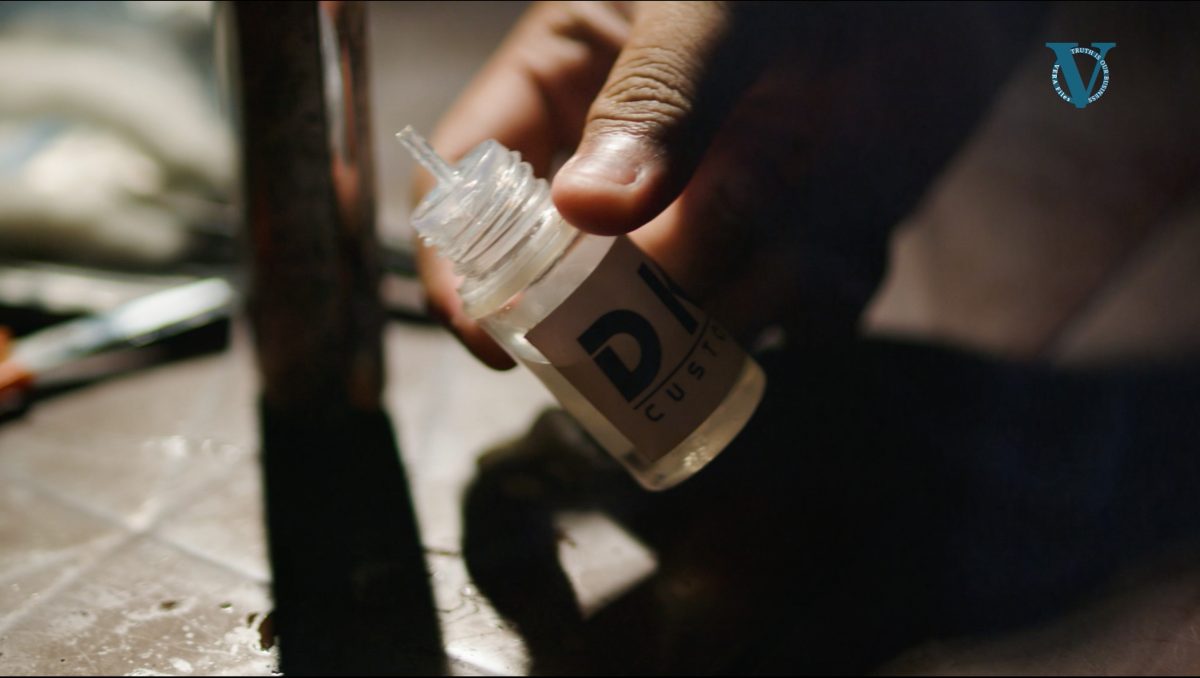Aware of the health risks of cigarette smoking, the tobacco industry has designed over the years “less harmful” alternatives for smokers: low and tar nicotine devices, filtered cigarettes, smokeless tobacco.
More recently, it introduced electronic nicotine and non-nicotine devices (ENDS/ENNDS), or e-cigarettes, and heated tobacco products (HTPs). (Read VERA FILES FACT SHEET: Smoke-free alternatives to cigarettes explained)
“After more than a decade of investment, we now have the science, technology, and the supply chain to produce and offer these products to smokers around the world,” Philip Morris International (PMI) says on its website.
“By offering a diverse portfolio of potentially less harmful products, we believe we can switch an even greater number of adult smokers faster, and increase our company’s presence in the category, while having a positive impact on public health,” it adds.
Of these “less harmful” products, the industry considers e-cigarettes and HTPs as the most “commercially successful” and “socially acceptable” alternatives.
In the Philippines, lawmakers have recognized and favored the harm-reduction potential of novel tobacco products over their negative effects on health. (READ: Sidebar on legislators’ votes)
The proposed Vaporized Nicotine and Non-Nicotine Products Regulation Act, ratified by Congress on Jan. 26, grants the Department of Trade and Industry (DTI) “exclusive jurisdiction” over “any and all issues, requirements, and subject matters” related to e-cigarettes or vapes, HTPs and their devices. It recognizes these novel tobacco products as “viable” alternatives for smokers who want to quit.
To date, the enrolled copy of the bill has yet to reach Malacañang. President Rodrigo Duterte has the option to sign it into law, allow it to lapse into law after 30 days from receipt, or veto the entire measure. Congress can override a veto with two-thirds vote in both the House and the Senate.
Novel tobacco products are under the regulation of the Food and Drug Administration (FDA) through Republic Act (RA) No. 11467 that Duterte signed on Jan. 22, 2020, but has yet to be fully implemented this May, and Executive Order (EO) No. 106, issued on Feb. 26, 2020.
Senate president pro tempore Ralph Recto, author of the vape bill, said the measure is for people who are already smoking and want to quit.
“I do not advise people who do not smoke to smoke. If you’re not a smoker, do not smoke,” he said on Sept. 13, 2021 in response to an interpellation during a plenary session. “Now, if you’re a smoker, and you want to prolong your life, stop smoking, and if you can’t, maybe shifting to e-cigarettes will be helpful.”
The new legislation, however, came even without a scientific consensus on several issues concerning e-cigarettes and HTPs.
Medical practitioners and health advocates say the bill’s provisions lowering the age of access to the alternative tobacco products from 21 to 18 years old and removing the two-flavor limit as provided in RA 11467 would entice younger people to try and eventually get hooked into vapes and HTPs.
In a Feb. 11 memorandum to the president, the Department of Health (DOH) warned that the bill, if enacted, “would allow even high school students to buy the products in retail establishments, including within malls.” (READ: Sidebar on age of accessibility)
Health authorities around the world appear divided on the scientific evidence that novel tobacco products can reduce harm. Locally, that rift runs deep.
Harm reduction is a strategy “to lower the total adverse consequences [from an undesired behavior] including those arising from continuation,” as defined by the United States (U.S.) Institute of Medicine Committee to Assess the Science Base for Tobacco Harm Reduction, published in 2001. Such policy intervention has been used in road safety, alcohol regulation, and sex education for teenagers.
The Philippine government and medical experts “must have the same definition of harm reduction,” according to Dr. Maricar Limpin, pulmonologist and president of the Philippine College of Physicians (PCP), in an interview with VERA Files.
“Harm reduction is when you reduce the risk from 100%. If you can reduce it to zero, the better… but harm reduction does not include increasing the risk,” Limpin says in mixed English and Filipino.
PCP joins the Department of Health (DOH), the FDA, and other prestigious medical groups such as the Philippine Medical Association (PMA) and the Philippine Pediatric Society (PPS) in opposing the vape bill.
A few medical practitioners, however, disagree and support the new legislation.
“The reason the tobacco control community has been so successful in the past is we spoke with a united voice,” says Dr. Ulysses Dorotheo, executive director of the Southeast Asia Tobacco Control Alliance (SEATCA), a multisectoral group that monitors and promotes the implementation of the World Health Organization Framework Convention on Tobacco Control (WHO FCTC).
“Now it’s fractured on the issue of e-cigarettes,” Dorotheo says.
The WHO FCTC, which entered into force on Feb. 27, 2005, is an “evidence-based treaty that reaffirms the right of all people to the highest standard of health” by developing a regulatory strategy to address the tobacco epidemic.
When the treaty was proposed in 2001, Dorotheo says “e-cigarettes are not what they are today.”
He recalls that experts discussed “harm reduction” as “reducing the content of nicotine in cigarettes so that it will be less addictive.”
“By having people less addicted to [c]igarettes, they will be smoking less and, therefore, be healthier. It’s easier to quit and [there is] less risk of disease,” he says. But Dorotheo notes that the definition of harm reduction is “totally different” today.
In a 2016 report on the impact of the treaty on the tobacco industry’s behavior, Dr. Stella Bialous, a tobacco control researcher and consultant, wrote that “reduced harm strategies need to be seen with some caution given the tobacco industry[‘s] long history of manipulating cigarette design and ingredients to increase its appeal and palatability.”
Bialous said since “less harmful” products are not “explicitly addressed by the Convention,” this creates an “opportunity to shield the industry from some regulatory measures and potentially stalling or reversing the progress made, to date, in denormalization of the tobacco industry.”
For Dorotheo, who has been a tobacco control advocate for over 25 years, the Congress-ratified vape bill is “pro-industry” because it “did not consider any of the inputs of the health sector,” including the lack of basis on tobacco harm reduction.
‘95% less harm’
While the DOH and FDA have taken a “cautious” stance on the available evidence about the health effects of e-cigarettes and HTPs, some lawmakers banked on oft-cited scientific reports that novel tobacco products are “95% less harmful than tobacco.”
In an August 2015 evidence report commissioned by the Public Health England, professors Ann McNeill and Peter Hajek said this estimate was based on the facts that carcinogens and other harmful substances found in cigarette smoke are “either absent” or “mostly at levels below 5%” in e-cigarette vapor. It was based on a “landmark” review published in 2014, looking into first-generation e-cigarettes (cigalikes, personal vaporizers or PVs).
Another report, published on April 28, 2016 by the United Kingdom (U.K.) Royal College of Physicians, said “the hazard to health arising from long-term vapor inhalation from the e-cigarettes available today is unlikely to exceed 5% of the harm from smoking tobacco.”
During interpellation on Sept. 13, 2021, Recto cited these scientific reviews as among “many studies that have been conducted,” proving that there is “sufficient evidence that vaping is safer than lighting a cigarette.”
Apart from Recto, pro-vape doctors have repeatedly claimed that “vapor products and HTPs are not completely risk-free, but they only carry a small fraction of the risk of cigarettes.”
Dr. Lorenzo Mata Jr., president of Quit For Good, a group advocating smoking cessation, said in the Asia Harm Reduction Forum on June 28, 2021: “Tobacco harm reduction, through the use and promotion of safer alternatives to combustible tobacco, should be employed to substantially reduce the risk of death and disease of smoking.”
He said his group has “submitted position papers to the [FDA], Bureau of Internal Revenue, [the] Senate, and [the] House of Representatives,” where it “raised issues on the perspective of the 17 million Filipino smokers who are trying to help and push for a differentiated, balanced, and consumer-centric approach to regulating smoke-free products.”
Quit For Good is a nonprofit organization of concerned citizens “who recognize the profound damage and loss tobacco cigarettes have brought to society.” Based on its Facebook page, the group “promotes harm reduction as a compassionate strategy to mitigate such damage and loss by providing patients with better alternatives.”
However, the Irish Cancer Society has pointed out that “while short-term evidence has found that e-cigarettes are less harmful than combustible cigarettes, e-cigarettes are not harm free, and more evidence is required to assess long-term risk.”
It notes that “the widely cited 95% figure is not based on a detailed review of evidence, supplemented by modeling.”
Health experts from the London School of Hygiene and Tropical Medicine, the University of Liverpool, and the Lancet also criticized the findings from the 2015 review of the Public Health England, saying it was “flawed” and “based on inconclusive evidence.”
Clinical epidemiologists and public health experts from the University of the Philippines Manila wrote in a 2018 scientific article that ENDS/ENNDS “still need further research to have conclusive results on long term safety and efficacy as smoking cessation methods.”
They said, “Since ENDS/ENNDS were only introduced to the market in 2006, only short to medium-term studies on its adverse effects are available.” The review was published in The National Health Science Journal Acta Medica Philippina on Sept. 30, 2019.
“[K]ailangan objective at balanced ‘yung view (The view has to be objective and balanced). [T]hey have to look at it in a very scientific way. And right now, there is really no proof to show that it is harmless, that it is healthy, because it is not,” says former FDA director general Dr. Eric Domingo about doctors who support pro-vaping claims.
“This is a very new technology… We want to make sure that whatever its effects are, short-term and long-term, must be established before you decide that this is something positive and something useful,” Domingo says in an interview with VERA Files.
Under Section 12 of the bicameral report on the vape bill pertaining to product communication restrictions, companies are allowed to add a “reduced risk statement” on their products. It defined reduced risk statement as an “explicit communication to consumers that [these] present less risk of harm to the user’s health than continued smoking of combustible cigarettes.”
This must be “authorized, validated, accepted, or permitted by reliable and mature agencies” and “be taken into consideration by the FDA in its resolution of an application for a reduced risk statement authorization” within 18 months.
It added that “these restrictions apply to commercial communications only and shall not prevent a company from providing information regarding its company, its products and other non-promotional information on Vaporized Nicotine and Non-Nicotine Products or Novel Tobacco Products.”
But Rodley Carza, head of the DOH Policy and Technology Division and the agency’s focal point on tobacco control, says adding a reduced risk label “sends the wrong message that it is [a] safer alternative which we know na hindi (that it is not),” explaining that evidence for new and emerging tobacco products “may not be existent yet.”
The vape bill follows RA No. 10643, which states that “all outside packaging and labeling” of tobacco products should carry 50% graphic health warnings. The variation is in the textual health warning placed on products with nicotine and without nicotine.
For DOH, the proposed law “limit[s] the application of graphic health warnings to just vapor product refills/consumables and exclude[s] the vape devices.”
Putting a “reduced risk statement” can even entice more people, especially the youth to take up these products, Carza says.
In harm reduction interventions, experts noted that “a lower perceived harmfulness may also increase intensity of use.”
A 2018 position paper of the PPS Tobacco Control Advocacy Group (TCAG) suggested that among the factors that attract younger people to try e-cigarettes is the “perception that those are healthier” than traditional cigarettes.
“Harm reduction is a bit tricky because what they claim as reducing harm is actually contrary to [t]he effect of that strategy,” Carza says, noting that smokers who use both conventional cigarettes and e-cigarettes or HTPs can “double their risk.”
The Philippines’ first reported vape-associated lung injury involved a 16-year-old dual user from the Visayas.
Pediatric disease experts have also drawn attention to the nicotine present in e-cigarettes and HTPs. Nicotine is the chemical compound naturally found in tobacco responsible for smoking addiction.
(Read Vape use could lead to alcohol and illegal drug use ー health experts and VERA FILES FACT SHEET: What lowering age restrictions on e-cigarette smoking means for the youth)
“In concentrated forms, 30 to 60 milligrams of nicotine is lethal for adults and 10 milligrams for children,” Dr. Mel Anthony Acuavera, a member of the tobacco control team of DOH, explains.
He says the percentage of nicotine delivered from e-cigarettes and HTPs is “influenced” by the type of nicotine, nicotine concentration in the refill, heating capacity of the device, and the puffing capacity or pattern of the user.
In novel tobacco products, nicotine is added to the e-liquid or e-juice, which the device heats to produce vapor. (Read: Sidebar on flavor and Vape bill exposes young ‘vulnerable’ consumers to health risks, endangers already weak enforcement)
Acuavera says, “the lower concentration, the better… If we look at the other countries, they are already pushing for lower levels of nicotine concentration in vape liquids.”
Vaping Facts, a website handled by the New Zealand Ministry of Health, pins nicotine strengths in e-cigarettes and HTPs between “zero and 50 milligrams.”
For freebase nicotine – or the original nicotine in e-liquids designed to create a “strong throat hit” – the substance must not exceed 20 milligrams per milliliter. For nicotine salts – or the “normal nicotine” that has been “pH balanced” designed to “feel much smoother on the throat” – the substance must not exceed 50 milligrams per milliliter.
“The total nicotine content in a container of vaping substance sold at retail must not exceed 1,800 mg, whether it is present as free-base nicotine or nicotine salts,” it wrote.
In Canada, the maximum nicotine concentrations for vaping products must not exceed 20 milligrams per milliliter.
The vape bill, under Section 18, allows up to 65 milligrams per milliliter of nicotine in e-cigarettes and HTPs.
In a Dec. 16, 2019 Senate journal, Recto explained that the nicotine cap limit is “reasonable” because the “ideal harm-reduction device” should deliver nicotine “as similar as possible” to conventional tobacco smoking. The 65 milligrams per milliliter, he said, maximizes “palatability” and mimics the experience of “cigarette smoking more closely.”
“Offering a sub-par nicotine product, such as a 20 milligrams per milliliter, would simply be a win for combustible cigarettes,” Recto added, claiming that a Filipino smoker “would most likely stick to the old ways because the nicotine experience in combustible cigarettes would be far more satisfying.”
Mata, who appeared as an expert resource person in legislative hearings, has argued that nicotine is not the problem.
Tar, a toxic chemical released when tobacco is burned, “contains most of the cancer-causing and other harmful chemicals found in tobacco smoke,” he says, quoting British psychologist Michael Russell.
Russell, known as the “father of tobacco harm reduction,” was found to have links with the British American Tobacco, a multinational company that sells cigarettes and other nicotine products.
Nicotine, indeed, is not cancer-causing but a toxic substance. Several health authorities cautioned that it can raise blood pressure and the likelihood of having a heart attack. Some recent studies have indicated that nicotine may contribute to the development of cancer.
Limpin, the executive director of nonprofit Action on Smoking and Health (ASH) Philippines, says that as scientific studies on novel tobacco products grow every year, the industry will have difficulty in keeping the catchphrase that e-cigarettes bear less harm.
Dorotheo says leveraging on the disagreement in the scientific community about how safe or harmful these products are is a “new tactic” of the tobacco industry. An “old tactic,” he says, would be to give research money to universities.”
As a result, pushing back against the insertion of e-cigarettes and HTPs “as part of the solution” to the smoking epidemic may seem that “tobacco control advocates are disregarding science,” Dorotheo tells VERA Files. “They’ve never made that claim before,” he adds.
A cursory search on the social media pages of pro-vape groups such as Philippine E-Cigarette Industry Association (PECIA), Nicotine Consumers Union of the Philippines, ProYosi, Vaper Ako, and The Vapers Ph showed that they have mounted campaigns anchored on “harm reduction.”
The WHO emphasizes that tobacco is harmful and “there is no safe level of exposure” to tobacco – whatever shape or form it takes. #
*VERA Files reached out to PMFTC, Inc., the Philippine affiliate of Philip Morris International, for its side of the story. The company, which controls over 90% of the local market, declined our requests for an interview and a comment to a set of questions “until [the vape bill is] officially acted upon by the Palace.
This story is part of the project Seeing Through the Smoke, which is supported by a grant from the International Union of Tuberculosis and Lung Disease (The Union) on behalf of STOP, a global tobacco industry watchdog.




